Let’s be real, marketing is kind of a drag—I know I personally hate being bombarded by ads I didn’t sign up to see, emails I didn’t ask for, and spammy ads in my social media feed.
What I much prefer is being entertained, reassured and supported by companies that actually have my best interest at heart.
Starting out just after college, I faced finances for the first time. I literally had no idea where to start. After a quick search for “finance basics,” I found SoFi’s blog post: 10 Personal Finance Basics:

After reading that post, and a few more, I signed up for their newsletter, and eventually, their money-management platform.
That’s content marketing.
I didn’t dread their marketing, I looked forward to it.
If you create content for your audience instead of marketing to them, the sales will flow. But to be successful, you have to become a credible and authoritative resource, earn your audience’s loyalty and trust, and grow an active subscriber base before you can increase profits.
What is Content Marketing?
Content marketing is the practice of creating and distributing content created with your audience’s needs in mind, as opposed to solely focusing on the benefits for your brand or product, in order to build an engaged audience to whom you’ll easily be able to sell.
Content Marketing Definition
When I’m asked to describe my job as a content marketer (typically around a place like the Thanksgiving dinner table), I usually respond back with a question: “Have you ever signed up for a newsletter or subscribed to a YouTube channel? Why?”
They usually respond yes, and explain to me that they either read or watched something they liked, and wanted to see more.
“That’s content marketing.” You’ll hear me say from across the table.
As a follow-up: “Did you then see anything related to that company or person’s products? Did you buy?”
If the answer is yes, you’ll hear me say, “that’s good content marketing.”
Here’s how to define it:
“Content marketing is the process of selling your products or service by creating and distributing content like videos, podcasts, infographics, blogs and more, for the express purpose of connecting with an audience on an incredibly empathetic level, providing value to that audience, and gaining their trust and credibility, in order to build a loyal subscriber base to whom you can then easily sell.”
It’s a mouthful, and a bit of an undertaking, but the benefits are extraordinary. If you do it right, you can build:
- A potential customer base that trusts you, and is loyal to you
- An authoritative and credible brand that people want to hear from
- A subscriber base that wants to hear from you, and to whom you can easily sell
- An endless supply of upper funnel leads to fuel your sales funnel
- A touchpoint for current and past customers, to keep them coming back again and again
This is not a new idea by any means—content marketing has been around a long time. The first, and now, famous example is Poor Richard’s Almanack, first published in 1732 by Benjamin Franklin.
Franklin didn’t create the Almanack out of the goodness of his heart—he did it to sell a printing business. He was the first to uncover the foundational truth behind content marketing: it’s not about your brand, product or service, it’s about your audience. So, he created something of value to them, and in return, his business flourished.
By putting your most empathetic and genuine foot forward, you prove that you truly care about your customers, and that they can trust you by giving you a slice of their precious budget.
Why Content Marketing?
Like I mentioned, content marketing can be a bit of an undertaking—so why content marketing? Content marketing works because at the end of the day, you’ll see more conversions and sales because you’ve worked to educate your audience while building a lasting relationship with them. In most cases, it works a lot better than traditional marketing tactics.
Many marketers already know this, which is exemplified by the huge brands that have jumped on the content marketing bandwagon—Sephora, LEGO, Bumble, Taco Bell, Patagonia, Dell Technologies and Marriott just to name a few.
Take Bumble’s The Buzz for example. This online magazine is a star example of content marketing, featuring stories of couples who’ve found love on the popular dating app, as well as tactical (and funny) tips and tricks for dating.
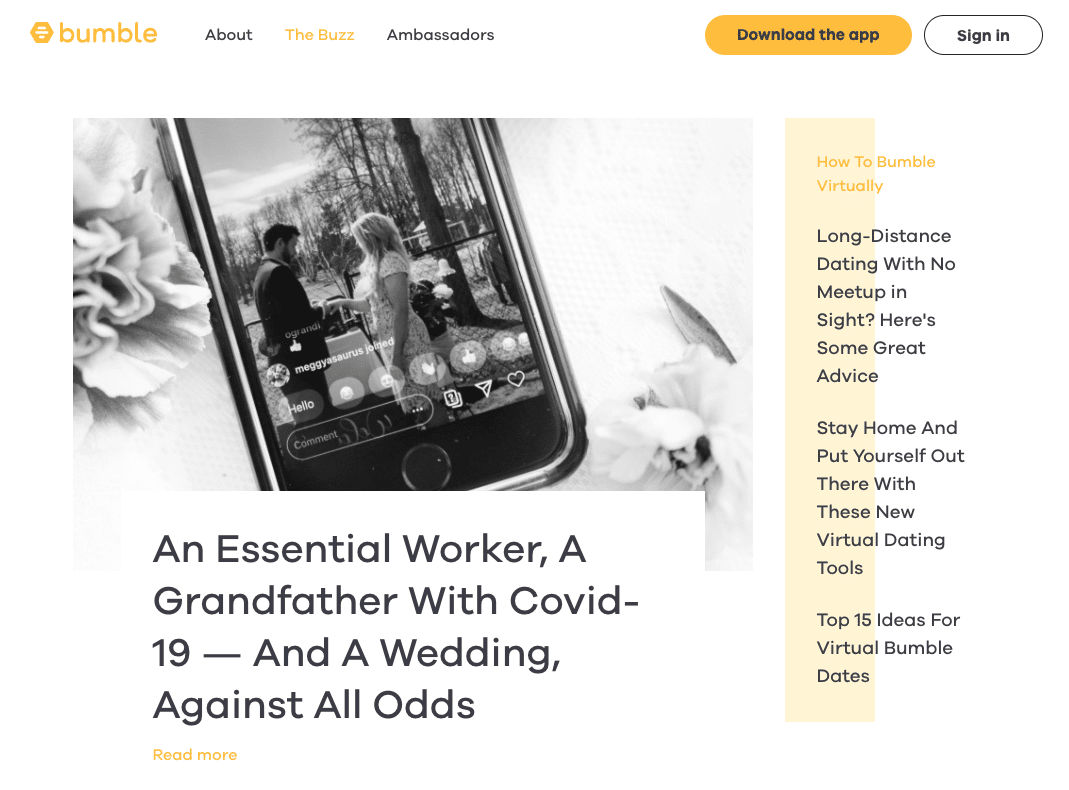
The content is relatable, inspiring, and is genuinely helpful for people looking for love online. And in the midst of all of that empathetic helpfulness, there are several calls-to-action (CTAs) or opportunities for those engaged readers to download Bumble’s app.
LEGO is another (bit overused) but powerful example. Have you seen The LEGO® Movie? You just experience a one hour and 41 minute content marketing campaign, in the form of a movie. A campaign that worked so well, they spent more millions of dollars to make another one.
These big brands (and many more) aren’t spending money to create this content out of the goodness of their hearts—they’re doing it because it’s impacting sales. Specifically, it’s impacting their sales in the following ways:
- It’s improving their brand awareness, or rather, the amount of people who know their company exists.
- It’s building their credibility and authority in their niche, making them and their employees thought leaders.
- It’s engaging the people that are now aware of their brand by providing them valuable content, but also ample opportunities to engage with more content, and eventually subscribe.
- It’s helping them generate leads, or build a subscriber base, to which they’ll be able to sell easily in the future.
- It’s provided them a massive list of people to whom they can now sell to for free, increasing sales.
While there are offline types of content marketing (as we demonstrated with our LEGO example), we’re going to focus on online content marketing, and how you can build an audience with digital content marketing campaigns that will eventually drive sales.
How Does Content Marketing Drive Sales?
Content marketing drives sales by moving a relevant and engaged audience down the funnel using content that’s incredibly valuable and empathetic to their needs. This content encourages that audience to subscribe to your email marketing updates, where you eventually sell to them, when they’re ready.
To do this successfully, the content you create must be chosen strategically, and must be mapped to your funnel.
Online Content Marketing Funnel
Your content marketing funnel should mirror your sales funnel, the only difference being that it highlights the content moving people through the buyer journey.
Content marketing can move people all the way from the top of the funnel to the bottom—to demonstrate how, we’ll walk through content in four basic stages:
- Awareness: the consumer doesn’t know you exist, and might not think he or she needs your product or service.
- Consideration: the consumer has need for your product or service, but isn’t sure you’re the right fit.
- Decision: the consumer is ready to buy, needs to be reassured you’re the right fit, and led through the sales process.
- Loyalty: the consumer has bought from you, and is in the position to buy again.
To illustrate these three stages of the funnel, meet Alex, Ana and Joseph.
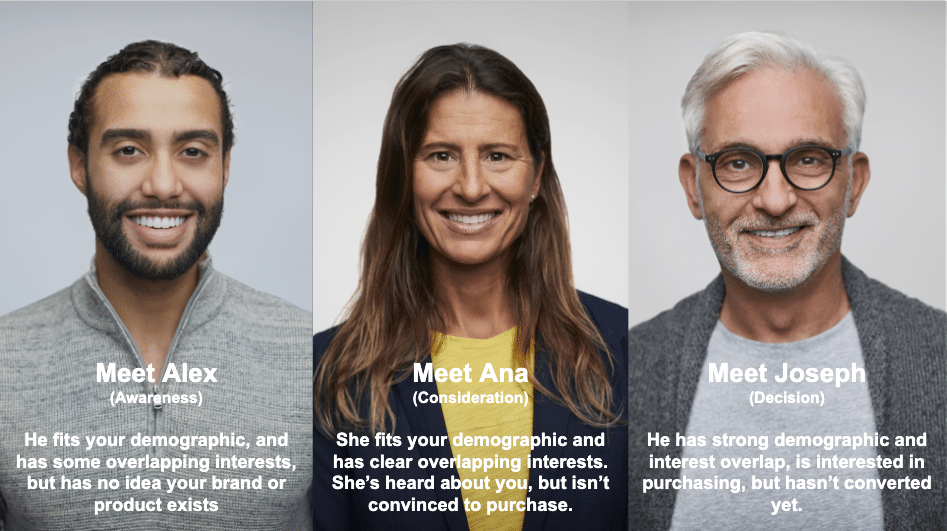
Each of these personas we’ve chosen is potentially a different member of your audience. If you reach them with valuable and relevant content for their stage of the buyer journey, from a place that’s genuinely empathetic to their needs, they have a much higher chance of moving closer to a sale.
Below is an example of what that journey might look like. Here’s the PDF, if you’re interested in the examples.

The content types here are a suggestion—you’ll have to experiment with your audience to find the type of content that resonates the most. In my humble opinion, infographics, blog posts, videos and other types of content can work at any stage of funnel—what’s really important is the subject matter.
At the top of the funnel, you shouldn’t be hard-selling at all. This content should exist purely to add value to your audience’s lives. The further your audiences gets down the funnel, the more you can freely talk about your products or services.
To illustrate this a bit further, here are example content funnels from the food, fitness and home and garden industries:
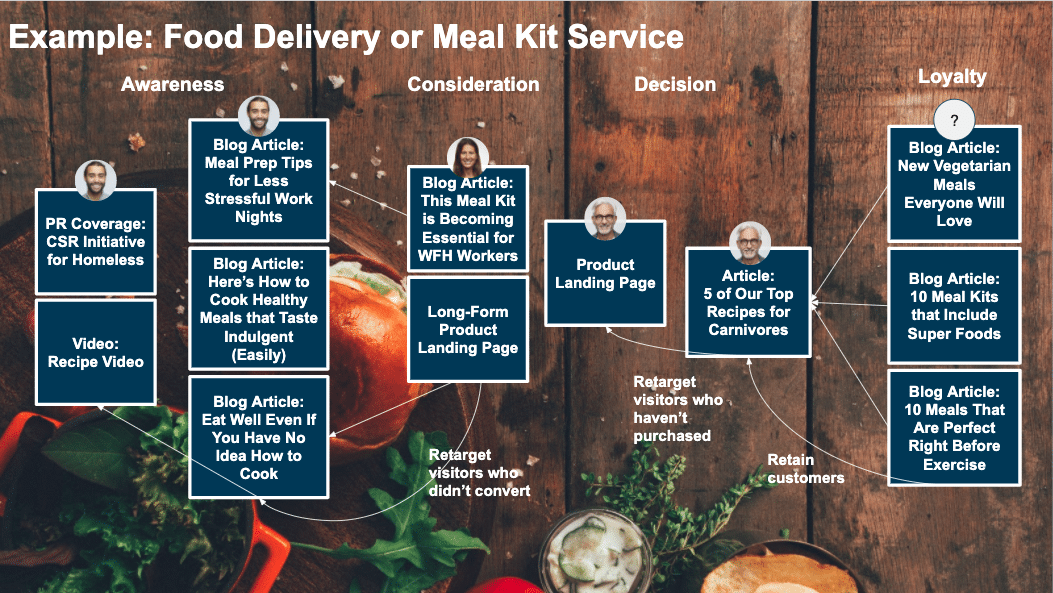


These example funnels look enticingly straightforward—it’s a wonderful dream to imagine that consumers move in a linear path through the funnel from awareness all the way to becoming a loyal customer.
In reality, marketers know that’s not the case. Consumers may move backwards and forwards through this funnel, skip steps or react in unexpected ways to the content you produce.
The only solution to this mess is easy to say, and very hard to do—keep providing them with valuable content in the right place, at the right time.
For that, you’ll need a solid distribution strategy, and digital content campaigns that hit the mark.
Digital Content Marketing Campaigns
A content marketing campaign is the process of creating and effectively distributing a piece of content, or multiple pieces of content, for a specific key performance indicator (KPI) at a specific stage of the funnel.
Maybe you’re a technology platform looking to increase the number of consumers in the awareness stage of your funnel. To engage them, you create content that showcases data from your platform, and provides those consumers valuable insights into your vertical or niche. To connect consumers with that content, you launch a social media campaign and measure the amount of new user traffic you receive on those pages as an indication of how many new people have discovered your brand through that content.
Sticking with the technology platform example, take Hootsuite’s 2015 Game of Thrones video campaign. Hootsuite wanted to increase awareness of their brand, so they created this video that illustrates the ‘Game of Social Thrones.’
The end card of this video is the soft-ball version of a call-to-action that says “remember us” with copy that simply states, “Hootsuite: Unite Your Social Thrones.” This campaign went viral when distributed on YouTube and other channels, and blew Hootsuite’s expectations out of the water.
Digital content marketing campaigns like this one need just three things to work:
- Great, valuable content in a format that’s engaging for your consumer base (text, video, audio)
- A distribution strategy that gets your content in front of the right people, in the right place, at the right time
- Measurement infrastructure that allows you to track your content’s return on investment (ROI), or rather, if the gains justified the means to make it in the first place
Sounds like a piece of cake. Just kidding, but it’s well worth the impact that doing it right can make in support of your brand and your sales efforts.
We’ve talked a lot about creating valuable content, but the distribution is just as important. There are two basic methods you can use to get your content in front of the right people when they want to see it: you can use organic distribution methods (those you don’t pay for) or paid distribution methods, like content advertising (those that you do pay for).
These are some of the most common content promotion tactics used by digital and content marketers alike:
- Content discovery: You might quickly think to reach consumers on search engines and social sites, but there’s the rest of the web to consider. Discovery platforms allow you to reach consumers on sites across the open web using paid advertising. This is what we do at Taboola.
- Organic social media: distributing content on your own social media channels to drive traffic to content, but also using these platforms to build relationships with consumers. This is an important part of any company’ distribution strategy, but it can take a while to build an engaged audience.
- Social media advertising: to reach consumers on social media quickly, you can purchase ads on social media sites to get your content in front of them faster.
- Search engine optimization (SEO): this is the process of building content that’s likely to rank high for a search term that’s relevant to you. Traffic flows when people search for that keyword and click on your content.
- Search advertising: you can also buy placements at the top of search keywords using paid advertisements, the same way you would on social sites.
- Public Relations: when you have something incredibly valuable to say, you can pitch publications to increase your reach.
- Pay-per-click (PPC) advertising: this technically covers discovery, social media and search ads as well, but you can also pay for things like display ads to attract more consumers.
- Email marketing: once consumers subscribe, you can continue to provide them valuable content through regular email marketing campaigns.
The third step, measuring these efforts, is admittedly hard. In a perfect world, we’d like to be able to see consumers interact with initial content, subscribe, interact with more content, and then purchase.
In reality, it’s tough to quantify the exact impact that content had on that consumer. Was it the blog post that convinced them? The Taboola ad they saw? Or the sales person? Here’s a guide to measuring your content marketing efforts and mapping those efforts to ROI.
How to Get Started with Content Marketing
There are a lot of potential starting points to grapple with if you’re just breaking into content marketing for the first time. There’s far too much to cover here in one post, but we’ll get you started with the basics and provide some resources that will allow you to take a deeper dive where you see fit.
Content Marketing Guide
Successful content marketing can only become possible when you’ve mapped the following:
- Key business and consumer needs, and how you can address them
- Where in the buyer’s journey or funnel you need to focus
- The appropriate content type or types in which to use to address those needs
- A content marketing strategy that maps the above three bullets, as well as a distribution and measurement strategy to report on your efforts.
Step 1: Define Business and Consumer Needs
Step one is the most critical, and the step that I’ve seen skipped the most by companies from all verticals. Mostly because it’s hard—to define key business and consumer needs, you need to have a lot of conversations.
Talk to consumers who’ve already purchased your product, and prospects if they’ll let you. Ask them questions like these to try to understand what they need from you:
- What was the ultimate deciding factor before you purchased our product? Was it price, a feature, because there was an immediate need and you needed to move fast?
- Did you do any research before making your buying decision? Where did you conduct that research?
- What problem are we solving for you in your daily life?
You might think you know the answers to the questions already, but you might be surprised. Once you’re done, turn to your sales teams and ask them:
- What moves the easiest? What products move the slowest?
- When customers decide not to make a purchase, why is that the case?
- What’s the most positive point of feedback you hear regularly from prospects? What’s the most negative?
Then, take the information from those conversations and fill in the gaps. Maybe you’re selling furniture for a home, and you’re constantly talking about pricing and discounts. In your conversations with consumers though, you learned quality was also an important factor—that should be an important piece of your content strategy.
Step 2: Map Content to the Funnel
You should have walked away from step one with some core content topics, pillars, or themes to focus on that meet both your business’s and your potential consumer’s needs.
The next step is more conversations in order to map the buyer journey with potential content topics that service those needs, and provide value at the right time.
Leaning on detailed buyer personas will help you (and if you don’t have them already, you should create them), as well as the templates provided above as a guide.
It’s important to note that you might not have to focus on the whole buyer journey. If you’re having trouble converting consumers at the consideration stage for example, start there, and branch out as your needs inevitably change.
Step 3: Choose Your Content Types
There are so many content marketing types to choose from, it can be a bit overwhelming. Each type of content provides a unique storytelling platform in order to get your message across to potential consumers.
I think the easiest way to break into content marketing is to start blogging. You can launch a blog for free, and it provides you the best opportunity to start collecting email subscribers.
In addition, a blog site can also host a ton of different types of content other than blog articles, like case studies, infographics and videos for example, if you want to experiment as you grow.
There are lists of content types out there that span a number from 13 to over 100, but I think this list from Larry Kim sums them up pretty well.
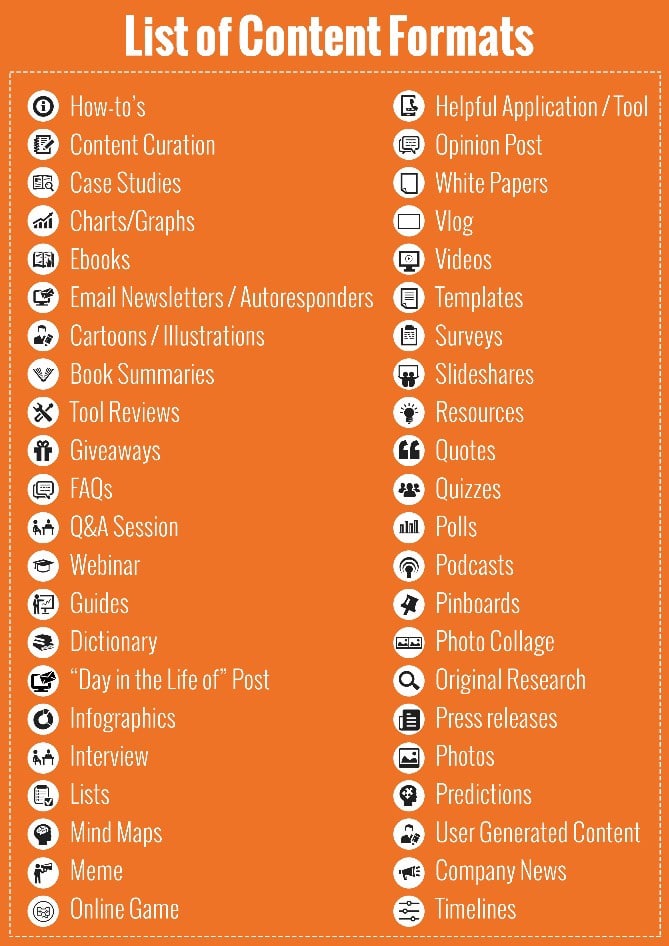
Step 4: Content and Distribution Strategy
The final step is to take all of this information you’ve gathered and document a plan. There is no one-size-fits-all content strategy template. Some people like to create written documentation, but I prefer a deck of some sort. They’re easy to pull out in meetings to help you brainstorm, explain and pivot as you go.
Your content strategy should outline all of the information you’ve gathered so far, as well as a distribution strategy that covers the following:
- Distribution channels
- Budget for distribution (if any)
- KPIs that relate to your defined business needs
- Measurement plan
The final step is creating an action plan—create a content calendar to keep you on track for creation and distribution of content. You can use a tool of some sort, or get started in a spreadsheet.
My content calendar has changed depending on the company I’ve been working with, but I’ve always thought this basic example from the Content Marketing Institute is a good place to start:

For a deeper dive into some of these steps, check out these content marketing tips and best practices.
Once you’ve completed the discovery and planning stages, the next stage is to dive into content creation. We’re going to focus on text-based content, as it’s the easiest to get started with and has the least amount of financial barriers for marketers.
How to Write Content
This is another topic in which probably thousands of books have been written, but we’ll dive into a basic starting point.
Writing content always starts with an idea. Check out this list of places to find content marketing ideas to get started.
Once you’ve got an idea to work with, it’s time to sit down to write. Every piece of content, whether it’s a blog post, landing page, email, or another content type should follow this basic flow:
- Push on the person’s paint point
- Agitate that pain
- Solve their problem
Take this example from First Round Capital’s blog, The First Round Review. Their article, “The One Tool Startups Need to Brainstorm, Test and Win” does this well.
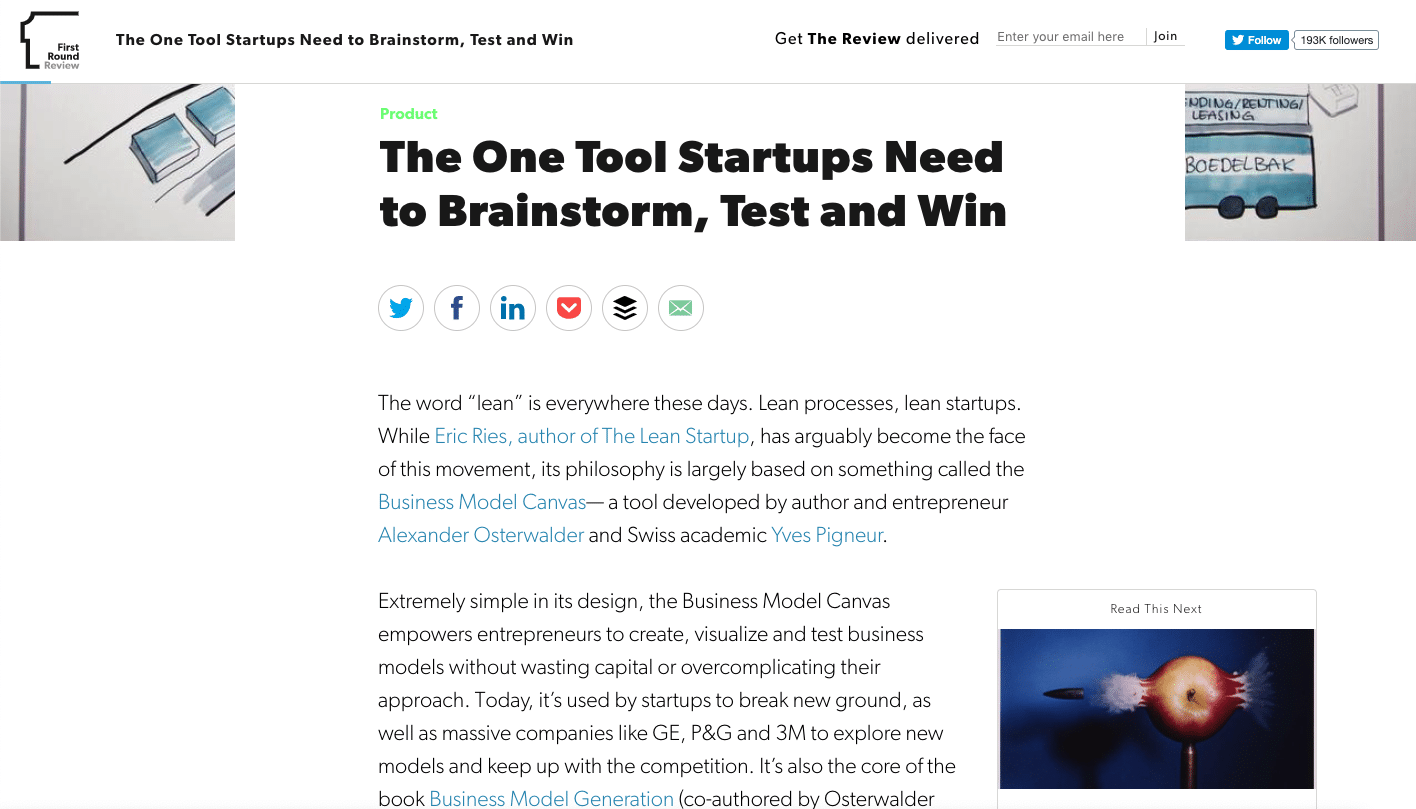
Let’s break it down on an incredible basic level:
- Pain point push: startups need a business model that works, while also operating lean
- Pain point agitation: your first business model is going to fail.
- Solution: a detailed description of the business model canvas.
Using this basic outline, they’ve gripped their audience from the start, agitated a pain point to convince them to stick around, and then solved that pain point elegantly.
This is also an example of the content type I recommended starting with—a blog post. Once you’ve determined the message that will flow from the three pillars above, here’s how to write on step-by-step:
- Collect all of the information needed. Are you showcasing propriety data? Interviewing one of your company’s thought leaders? Collecting data from the industry? Start there, and collect it all in a messy document.
- Outline your post. Include multiple options for a headline (I’d bet your first is never the one you choose) and all section headers. Drop in the information from your messy document where it belongs.
- Draft your copy. What you want to say is already on the page, now, sit down and let the words flow.
- Have at least one other person read it, including all necessary stakeholders. You should never publish anything that hasn’t been seen by a second pair of eyes.
- Publish.
The best advice I’ve heard regarding content creation came from Neil Patel: “The best content is content you want to read. The best content you would pay to read.” If you wouldn’t pay to read it, make more edits until you would.
How is Content Marketing Used?
The best way to answer this question is to show you some content marketing examples that I’ve found inspiring.
Deloitte Greenhouse™ Experience Group’s Book Launch
In order to support their consulting business, Deloitte published “Business Chemistry,” an amazing piece of thought leadership that undoubtedly provides value to their audience, and proves that Deloitte is the authority when it comes to running your business smoothly.

Blinkist Magazine Drives App Downloads
Blinkist needed a platform that would allow them a little more storytelling. The combination of Blinkist Magazine and a distribution strategy that includes Taboola successfully brings them app downloads.
Western Union’s One Year in the Dark
This touching content marketing example from Western Union tells the story of Americans without power in Puerto Rico after one of their worst hurricanes, and touches on their financial stress, which Western Union can help with.
Synchrony’s State of Pay Program
Synchrony wants to be positioned as an expert in payment innovation. To support that goal, they launched their State of Pay portal, which is packed with valuable content for business owners looking for payment solutions.

These are some of the best examples, but there are countless more.
If you needed anymore convincing on the value of content marketing, I’d hope some of these stellar examples from brands making the investment are evidence enough that it’s indeed worth the effort.
Your content marketing function can be as big or as small as you see fit, but one thing should always be your guiding light—providing genuinely valuable content that’s empathetic to your audience’s needs. Over time, you’ll see that all of the work you put into content will surely pay off.